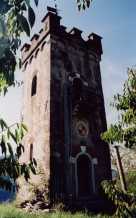
the “Roman” tower, aka “prisons” tower

| ||
|
the “Roman” tower, aka “prisons” tower |

One, surrounded by the vineyards near the town Faver, was built in medieval style, in 1911, by the nobles Tabarelli de Fatis, but until 2007 an adjoining road sign said “TORRESELLA - SEC. XV” (“Little tower. 15th century”)! It's not clear who put it, but the indication had been standing there for a few years. The picture on the left refers to that tower. |
